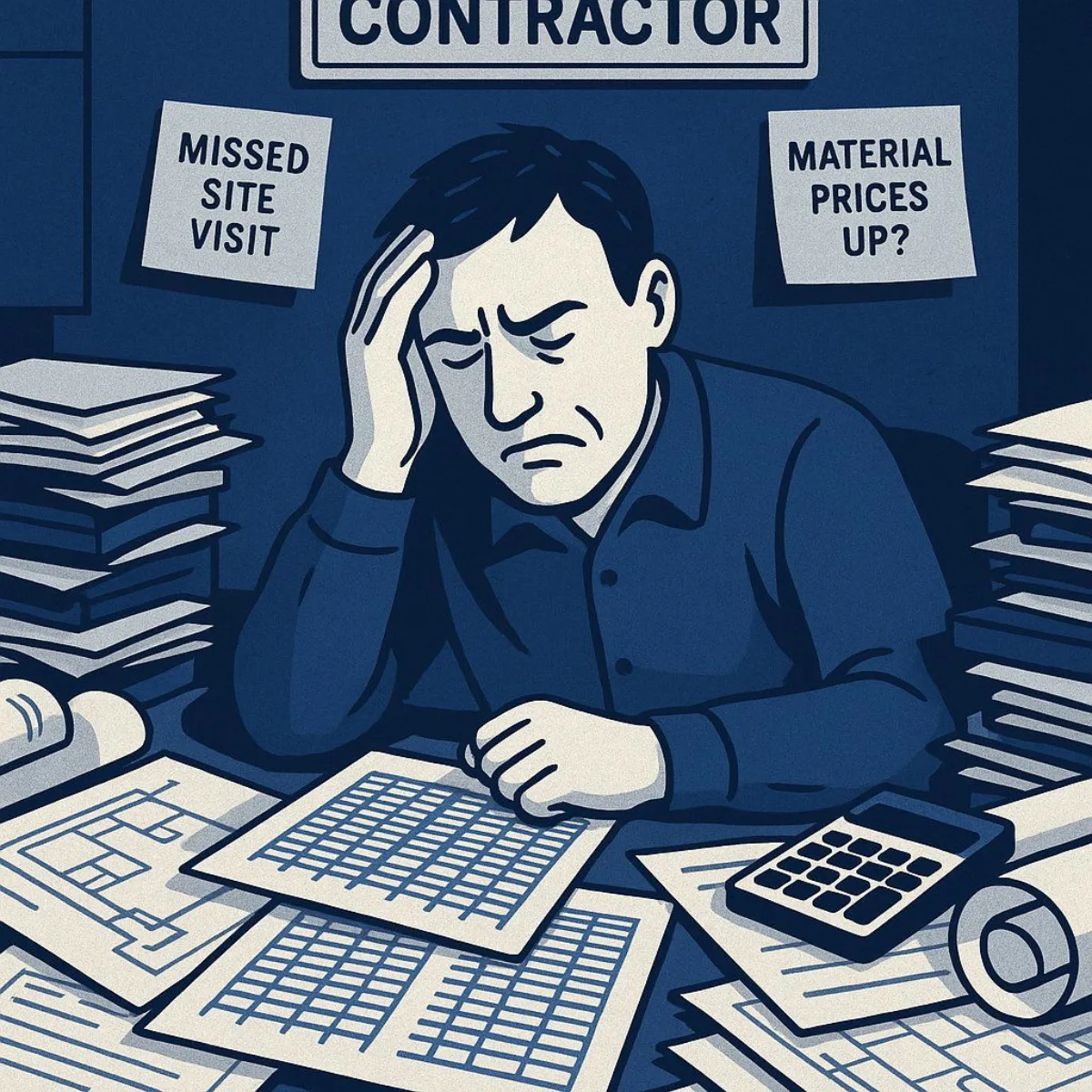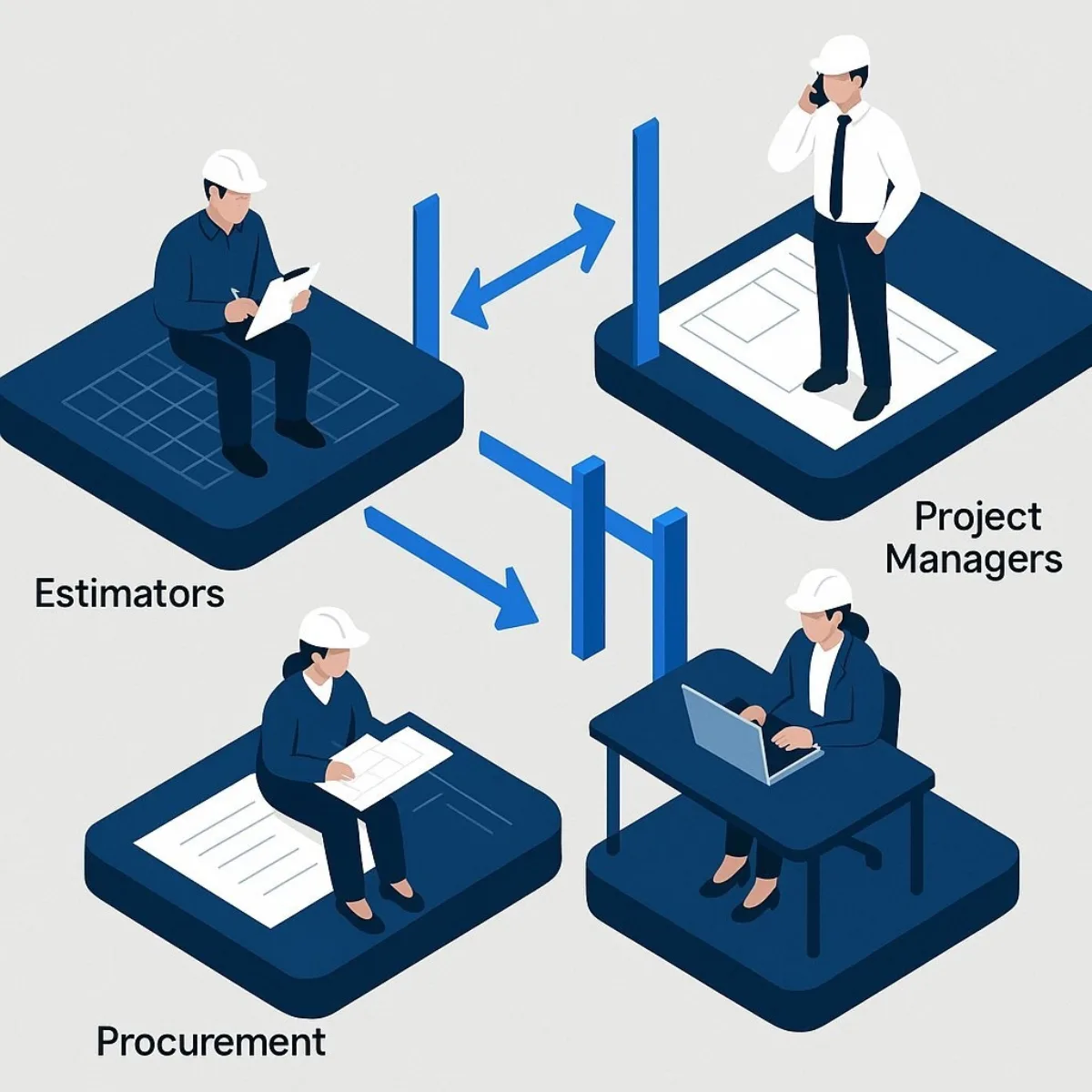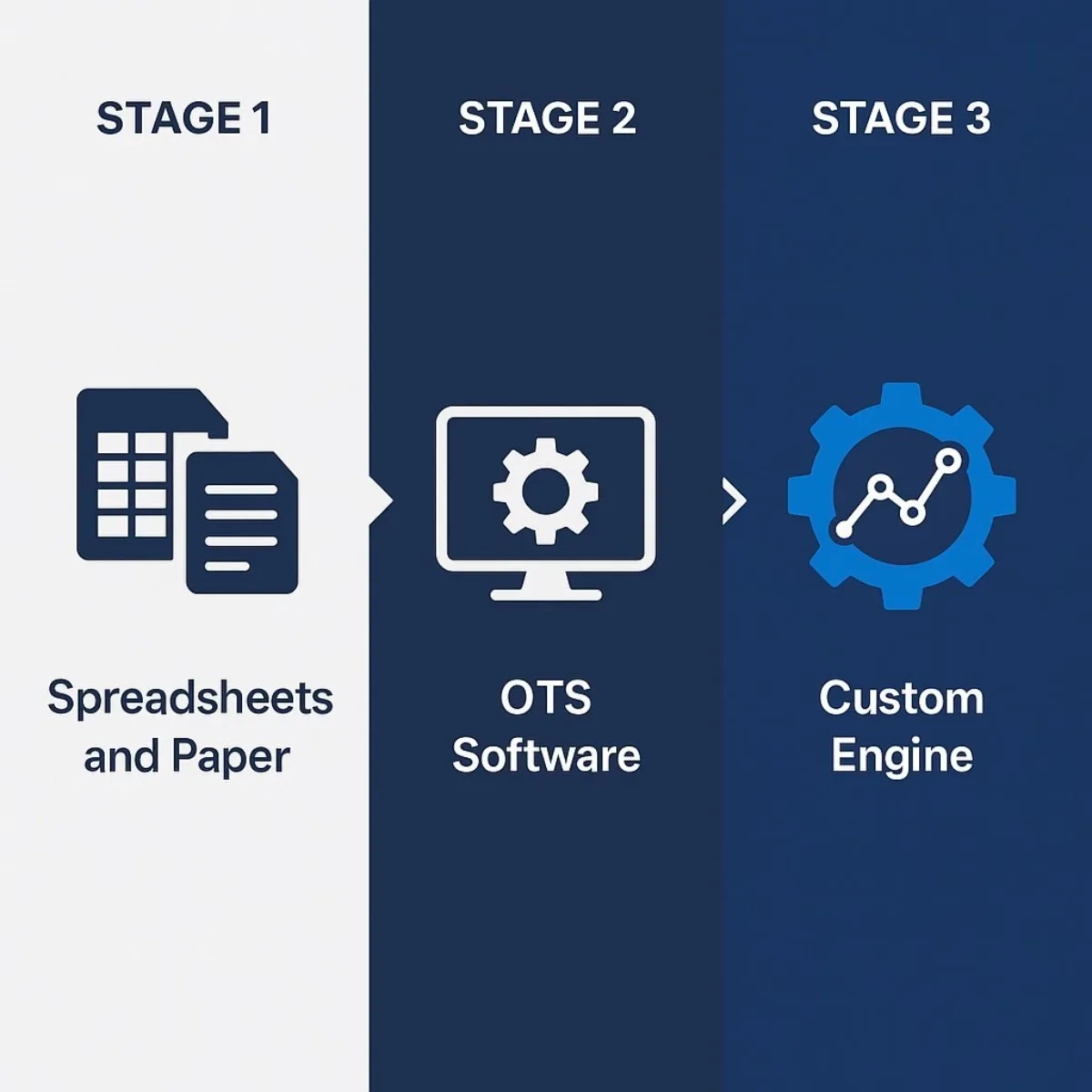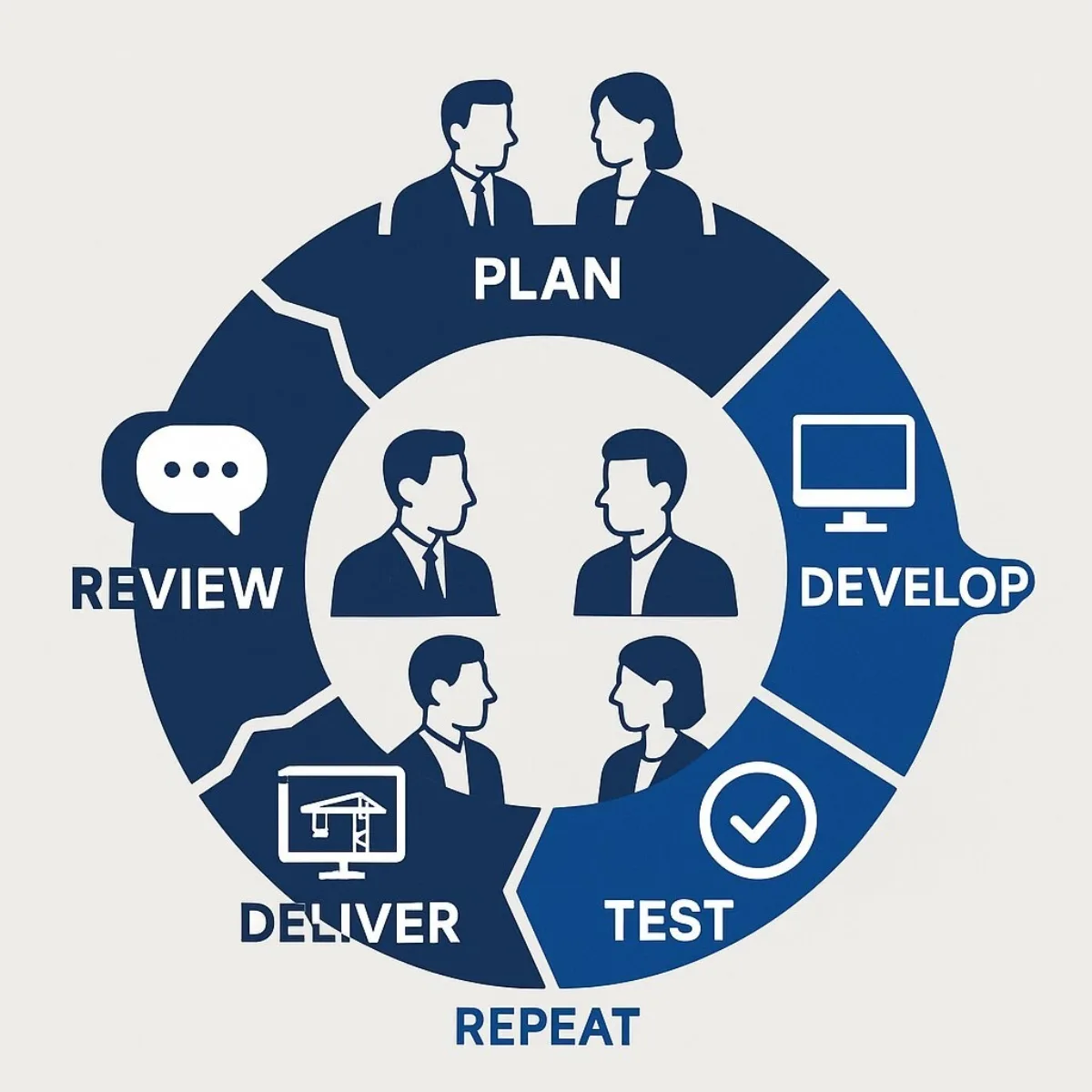
Custom Construction Bidding Software: Your Edge in Complex Estimates
August 19, 2025 / Bryan ReynoldsComplex Construction Estimates & Bids: How Can Software Help?

The question of how software can help with complex construction estimates and bids is not just an operational query; it's a strategic one with billion-dollar implications. In an industry where the stakes are astronomically high, the bidding process is more than just a preliminary step—it is the financial engine and primary risk management function of the entire enterprise. Consider the sobering statistics: a landmark McKinsey report found that 98% of megaprojects incur cost overruns of more than 30%, with the average cost ballooning by a staggering 80% and schedules slipping by an average of 20 months. More recently, a KPMG study revealed that only 31% of construction projects in the last three years came within 10% of their budget.
For most contractors, the "bid-hit ratio"—the measure of bids won versus bids submitted—is a constant source of anxiety, with firms typically losing far more than they win. This isn't just bad luck; it's a symptom of a deeper issue. The construction industry has been plagued by flat productivity for decades, a stark contrast to the manufacturing sector, where productivity has nearly doubled in the same period. This productivity gap is the fertile ground in which bidding failures take root. It suggests that the problem isn't just about isolated mistakes but about a systemic reliance on outdated, low-productivity processes.
Therefore, the real question isn't just "How can software help?" but "How can software transform this critical business function from a high-risk gamble into a sustainable competitive advantage?" This report will dissect the anatomy of a losing bid, evaluate the capabilities and limitations of standard software, and make the strategic case for a new approach: building a custom, intelligent bidding engine that turns a company's unique expertise into its most powerful asset.
The Anatomy of a Losing Bid: Why So Many Construction Estimates Fail
To solve the problem of failed bids, one must first diagnose it accurately. The challenges are multifaceted, but they generally fall into three interconnected categories: flawed processes, poor data integrity, and an inability to account for volatility. These issues create a "risk chain reaction," where one failure cascades into another, leading to a bid that is fundamentally broken before it's even submitted. A tight deadline, for example, forces an estimator to rush, which leads them to skip a critical site visit and rely on an "educated guess" that fails to account for unforeseen conditions or volatile material prices—a single point of pressure triggering a system-wide failure.
The Tyranny of Manual Processes & Human Error
At the heart of many failed estimates is a reliance on manual processes that are both inefficient and dangerously prone to error. The traditional, spreadsheet-driven approach is a minefield of potential mistakes.
Estimators often spend nearly half their time—a full 50%—on the laborious task of manual takeoffs alone. This disproportionate time sink leaves little to no bandwidth for higher-value strategic activities like risk analysis, vendor negotiation, or value engineering. The process itself, which involves gathering data, inputting it into disconnected spreadsheets, and performing calculations by hand, is inherently time-consuming and ripe for human error.
A single misplaced decimal, a transposed number in a spreadsheet formula, or a misread blueprint dimension can compound into a catastrophic financial error, capable of wiping out an entire project's profit margin. Many firms, under pressure, fall back on "educated guesses" or base their numbers on experience from supposedly "similar" projects. This method invariably overlooks project-specific details, leaves the company vulnerable to costly omissions, and makes it nearly impossible to justify the final price to a client.
The Data Integrity Gap: Vague Plans and Siloed Information

Even the most meticulous estimator is powerless against flawed or incomplete information. A perfect process cannot fix bad inputs, and in construction, bad inputs are rampant. A primary pain point across the industry is the lack of organized, accurate, and transparent data in the tender documents provided by clients.
According to the American Institute of Architects, a staggering 70% of construction projects experience delays or cost increases directly attributable to poorly defined plans and specifications. When bid documents are ambiguous or contain mistakes, it opens the door to misinterpretation, flawed assumptions, and ultimately, inaccurate estimates. These scope gaps, whether honest mistakes or deliberate omissions, inevitably become costly variations and disputes down the line.
This problem is compounded internally by the lack of a "single source of truth." When estimators, project managers, and procurement teams work from different versions of documents or siloed spreadsheets, miscommunication and rework are guaranteed. This lack of real-time collaboration forces estimators to work in isolation, unable to get timely input from the field or other departments, further increasing the risk of critical omissions.
The Volatility Equation: Market Fluctuations and Unforeseen Risks
The final piece of the puzzle is the inability of manual processes to cope with external volatility and risk. Construction does not happen in a vacuum; it's subject to a host of unpredictable forces that can render an estimate obsolete the moment it's submitted.
Market volatility is a chief concern. The prices of critical raw materials like steel, lumber, and copper can fluctuate dramatically due to global supply and demand dynamics, yet contractors are often locked into fixed-price contracts. Labor costs are equally challenging to predict, with varying wages, insurance, taxes, and the availability of skilled subcontractors creating a complex and ever-changing cost landscape.
Beyond market forces, a failure to properly assess and price for risk is a cardinal sin in estimating. Every project carries inherent risks, including:
- Unforeseen Site Conditions: Issues like soil instability or discovering unexpected underground utilities can lead to significant, unbudgeted costs.
- Weather and Logistics: Failing to build in contingencies for adverse weather conditions or logistical delays can derail schedules and budgets.
- Supply Chain Disruptions: Events like pandemics or geopolitical conflicts can disrupt the flow of essential materials, leading to costly delays.
- Regulatory Changes: New safety or environmental regulations can be introduced mid-project, adding compliance costs that weren't in the original bid.
The following table summarizes these critical pitfalls and their direct consequences, translating operational failures into the financial language that matters to executives.
| The Pitfall | Common Root Causes | Direct Financial Impact |
|---|---|---|
| Inaccurate Cost Estimation | Manual takeoff errors, outdated price lists, overlooked scope items, simple calculation mistakes. | Eroded profit margins, project losses, cash flow crises, damage to company reputation. |
| Incomplete/Ambiguous Bids | Vague design documents, missing specifications, failure to submit all required paperwork. | Bid disqualification, misunderstandings leading to disputes, costly change orders and rework. |
| Poor Risk Management | Failure to conduct site visits, no contingency for weather or supply chain issues, underestimating liabilities. | Unforeseen costs leading to budget overruns, project delays, potential for financial loss on the project. |
| Inefficient Workflow | Time-consuming manual processes, tight deadlines, poor internal communication and collaboration. | Rushed, half-baked estimates, reduced bid capacity (fewer bids submitted), high overhead costs for estimating team. |
The Standard Toolkit: Off-the-Shelf (OTS) Estimating Software
Faced with the chaos of manual processes, many construction firms have turned to off-the-shelf (OTS) software as a first line of defense. Platforms like Procore, Autodesk Construction Cloud, and Sage Estimating represent a significant leap forward, bringing a much-needed layer of structure and automation to the bidding process. For many, these tools are the first step in their digital transformation journey.
Core Capabilities and Immediate Gains
The primary value of OTS software lies in its ability to automate repetitive tasks and centralize information, addressing the most glaring issues of manual estimation. Key features typically include digital takeoff tools, built-in cost databases, standardized bid templates, and basic proposal generation capabilities.
The benefits are immediate and tangible. By automating calculations and providing digital tools for measuring plans, these platforms dramatically increase speed and reduce the likelihood of simple human error. One case study, for instance, found that a residential construction firm reduced its estimation time by 40% after implementing an OTS solution. This efficiency gain allows estimators to focus on more than just tedious takeoffs and enables firms to increase their bid volume. Furthermore, by providing a centralized, cloud-based platform for all bid-related documents, these tools improve organization and create a single, accessible repository for the estimating team.
Hitting the Ceiling: The Inherent Limitations of OTS
While OTS software solves many of the problems of manual methods, ambitious and complex firms often find they quickly hit a ceiling. The very nature of these one-size-fits-all solutions creates a new set of strategic limitations.
The most significant drawback is the imposition of rigid, standardized workflows. OTS software is designed for the "average" construction company. It forces users to adapt their unique, often proprietary, business processes to the software's predetermined logic. For a firm whose competitive advantage lies in a unique method of risk assessment or a specialized approach to subcontractor selection, being forced into a generic mold is not just inconvenient—it's a strategic liability. It commoditizes what should be a key differentiator.
This is compounded by the integration gap. OTS estimating tools often operate as information silos, disconnected from a company's core business systems like its Enterprise Resource Planning (ERP), Customer Relationship Management (CRM), or accounting software. This lack of connectivity perpetuates manual data entry, as winning bid information must be re-keyed into project management and financial systems. This not only reintroduces the risk of error but also prevents the creation of a crucial feedback loop where actual project costs and performance data can inform and improve future estimates.
Finally, there are concerns about long-term cost and scalability. While a subscription may seem affordable initially, these costs can become substantial as a company grows and adds users. The ongoing fees for a tool that doesn't perfectly fit the business can outweigh the benefits, especially when compared to the long-term value of a wholly-owned asset. The lack of standardization within the construction industry itself makes it nearly impossible for any single OTS product to be a perfect, scalable fit for every firm's unique needs.
The Competitive Edge: Building a Bidding Engine with Custom Software
For companies that have outgrown the limitations of off-the-shelf solutions, the next evolutionary step is to build a custom bidding engine. This approach flips the script: instead of forcing your business to conform to the software, you build software that is a perfect digital expression of your business strategy. This is where a firm like Baytech Consulting, with its focus on crafting tailored technology solutions, provides a distinct advantage. It's about moving from simply using a tool to owning a strategic asset.
Your Process, Your Platform: The Tailored Tech Advantage
The fundamental premise of custom software is that it starts with your unique business process, not with a pre-defined set of features. A custom-built platform is designed from the ground up to mirror, automate, and enhance the proprietary workflows that give your company its competitive edge.
If your advantage lies in a complex, multi-factor risk scoring model for new projects, that model becomes the core of the software's logic. If you have a unique way of vetting and managing subcontractor relationships, that process is digitized and scaled. This Tailored Tech Advantage transforms your team's operational expertise—your company's "secret sauce"—into a protected, scalable, and technology-enabled asset that competitors cannot replicate by simply buying the same OTS subscription.
Unifying Your Business Intelligence: The Power of Integration
Perhaps the most powerful aspect of a custom solution is its ability to break down the data silos that plague most organizations. A key benefit of custom software is its designed-for-purpose ability to integrate seamlessly with all of a company's other critical systems, including ERP, CRM, accounting, and project management platforms.
The impact of this integration is profound. One case study of a large construction firm that implemented a custom management platform to unify its disparate tools reported a 50% reduction in data entry errors and over $150,000 in annual savings on third-party licensing fees alone.
More strategically, this creates a "single source of truth" and a powerful data feedback loop. Information from a winning bid flows automatically and accurately into the project management system to set budgets and schedules. As the project progresses, actual cost and performance data from the ERP and field reports flow back into the bidding engine. This continuous cycle means that every new estimate is informed by the real-world performance of every past project, making the entire system smarter and more accurate over time.

From Reactive Bidding to Predictive Estimating
With a unified data foundation, a custom engine can move beyond simple estimation into the realm of predictive analytics. This is a leap that is simply not possible with siloed OTS tools. By applying modern data science techniques to integrated historical data, a custom system can:
- Identify Winning Patterns: Analyze past bids to understand which types of projects, clients, or general contractors lead to the highest win rates and profit margins, allowing you to prioritize efforts strategically.
- Implement AI-Driven Risk Analysis: Use machine learning algorithms to scan project plans and historical data to flag potential risks—like unusual design elements or dependencies that led to overruns in the past—with greater accuracy than human analysis alone. If you're looking for ways to integrate AI in construction project management, this approach is fast becoming the gold standard.
- Conduct "What-If" Scenario Planning: Model the financial impact of different material costs, labor rates, or risk contingencies, allowing executives to make data-driven decisions about bid strategy and margins.
The Technology Foundation for Enterprise-Grade Performance
To deliver these advanced capabilities, a custom solution must be built on a modern, robust technology foundation. This is where the expertise of a high-quality engineering team becomes critical. For a CTO, knowing the platform is built for the future is paramount.
Enterprise-grade applications today are built on scalable and secure cloud platforms like Microsoft Azure, which provides the global infrastructure needed for demanding workloads. The application architecture often uses Docker and Kubernetes to containerize and orchestrate different parts of the software, making them portable and easy to manage. These containers are then orchestrated using Kubernetes (often via a managed service like Azure Kubernetes Service - AKS), which automates deployment, scaling, and operations. This modern tech stack, a core competency at Baytech, ensures the custom bidding engine is not a rigid, monolithic application but a flexible, secure, and highly scalable platform ready to evolve with the business.
The journey from manual chaos to a strategic bidding engine can be visualized as a maturity model, helping executives identify their current state and the path forward.
The Strategic Decision: A Framework for Choosing Your Path
The choice between off-the-shelf software and a custom-built solution is not merely a technical or financial decision; it's a strategic one about how a company chooses to compete. The right path depends on a firm's complexity, ambition, and the degree to which its internal processes are a source of competitive advantage.
A Tale of Two TCOs: OTS vs. Custom
A simplistic comparison of upfront costs is misleading. A strategic evaluation requires a look at the Total Cost of Ownership (TCO) and the potential Return on Investment (ROI) for each path.
The TCO of an OTS solution goes far beyond the monthly subscription fee. It includes the cost of initial training, the ongoing labor costs of manual workarounds for processes that don't fit, the cost of errors from continued manual data re-entry into other systems, and most importantly, the strategic cost of commoditizing your core bidding process.
The TCO of a custom solution involves a higher upfront development cost plus ongoing maintenance and support, which is typically estimated at 15-25% of the initial cost annually. However, the ROI is measured in tangible gains: hard cost savings from eliminating multiple subscription fees, massive efficiency gains from full automation, reduced financial losses from fewer errors, and significant revenue growth from higher win rates and better project selection. As seen in the case of the large contractor that saved over $150k annually on licensing fees alone, the payback period for a custom solution can be surprisingly short. If you're reconsidering your digital strategy, the key is choosing the right technology approach for your business stage—take a look at this practical comparison of low-code vs custom software.
This table provides a strategic, at-a-glance comparison to help executives weigh the trade-offs.
| Strategic Factor | Off-the-Shelf (OTS) Software | Custom-Built Software |
|---|---|---|
| Workflow Fit | Generic; forces the business to adapt to the software's process. | Tailored; software is built to match and enhance the business's unique process. |
| Integration Capability | Limited; often creates data silos requiring manual data transfer. | Seamless; designed to integrate with core systems (ERP, CRM, Accounting) for a single source of truth. |
| Competitive Advantage | Low; uses the same process as competitors, leading to commoditization. | High; digitizes and scales a firm's proprietary process, creating a defensible asset. |
| Long-Term TCO | Lower entry cost, but accumulating subscription fees and hidden costs of inefficiency can be high. | Higher initial investment, but lower long-term operational costs and no recurring license fees. |
| Scalability | May become constraining as business complexity grows. | Built on modern cloud architecture to scale with the business. |
| Speed to Implement | Faster initial deployment. | Slower initial build, but can deliver value quickly through agile methods. |
The Agile Advantage in a Fast-Moving Market
The prospect of a large-scale custom software project can be daunting, often conjuring images of long timelines and uncertain outcomes. However, modern development methodologies have fundamentally changed this equation. At Baytech, we leverage a Rapid Agile Deployment approach, which is critical for delivering value in a dynamic market.

Unlike traditional "waterfall" projects, Agile development works in short, iterative cycles called "sprints," which typically last one to four weeks. At the end of each sprint, a working piece of the software is delivered. This approach has several profound business benefits:
- Faster Time-to-Market: Firms using Agile report getting products to market up to 40% faster, meaning the ROI from the custom solution starts accruing much sooner. This is particularly valuable if your organization wants to scale platforms and technologies with agility as needs evolve.
- Predictability and Transparency: Costs and schedules are predictable on a sprint-by-sprint basis, and stakeholders are deeply involved throughout the process, providing feedback and ensuring the project stays aligned with business goals.
- Adaptability: Most importantly, Agile embraces change. If market conditions shift or a new business strategy emerges, the software's direction can be pivoted in the very next sprint. This ensures the final product is never obsolete and perfectly meets the evolving needs of the business.
Conclusion: Stop Bidding, Start Strategizing
In the high-stakes, low-margin world of construction, the quality of a company's bidding process is a direct predictor of its long-term success. The evidence is clear: a generic process, whether manual or powered by generic software, will yield generic—and often poor—results. To consistently win the right projects at the right margins, firms must evolve from simply preparing estimates to conducting strategic, data-driven bidding. The choice of software is therefore not an IT decision; it is one of the most critical business strategy decisions a leadership team can make.
The journey of technological maturity moves from the manual chaos of spreadsheets to the standardized efficiency of off-the-shelf tools. While OTS platforms provide a valuable service, they represent a strategic plateau. For firms whose complexity and unique processes are a source of competitive strength, the ultimate goal is to create a fully integrated, custom bidding engine—a system that captures, scales, and continuously improves upon the company's core intelligence.
The path forward begins with a candid internal assessment. Leaders should audit their current bidding process, identifying the bottlenecks, data silos, and sources of error. They should challenge themselves to quantify the cost of a single major bid lost due to an avoidable mistake or a single project that suffered a significant overrun because of a flawed estimate.
For those firms who find their growth and unique strategies are being constrained by their tools, the next step is a strategic conversation. It's about finding a technology partner who understands not just how to write code, but how to translate complex business logic into a powerful, enduring competitive weapon.
If you're ready to transform your bidding process from a cost center into your most valuable asset, let's talk. Contact Baytech Consulting for a no-obligation strategic consultation. For more insight on quantifying returns and making the business case, check out this CFO’s guide to calculating the ROI of custom software.
Supporting Articles for Further Reading
- The construction productivity imperative
- https://www.rics.org/news-insights/digitalisation-in-construction-report
- A CFO's Guide to Calculating the ROI
- How Artificial Intelligence is Transforming Construction Projects
- Balancing Customization and Speed in Enterprise Software
- Agile Methodology at Baytech Consulting
- Scaling Kubernetes in the Enterprise: A Strategic Guide
About Baytech
At Baytech Consulting, we specialize in guiding businesses through this process, helping you build scalable, efficient, and high-performing software that evolves with your needs. Our MVP first approach helps our clients minimize upfront costs and maximize ROI. Ready to take the next step in your software development journey? Contact us today to learn how we can help you achieve your goals with a phased development approach.
About the Author

Bryan Reynolds is an accomplished technology executive with more than 25 years of experience leading innovation in the software industry. As the CEO and founder of Baytech Consulting, he has built a reputation for delivering custom software solutions that help businesses streamline operations, enhance customer experiences, and drive growth.
Bryan’s expertise spans custom software development, cloud infrastructure, artificial intelligence, and strategic business consulting, making him a trusted advisor and thought leader across a wide range of industries.


